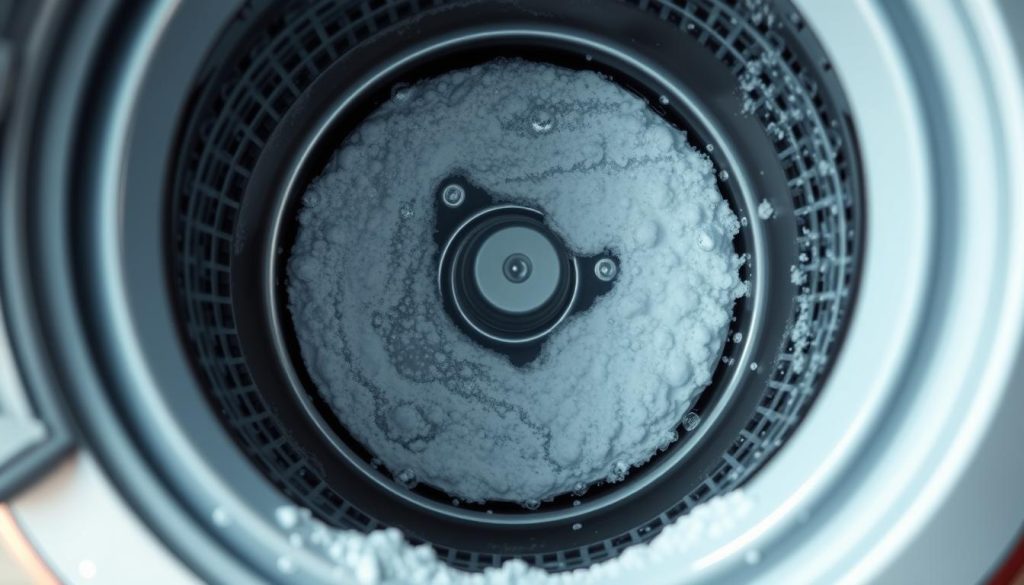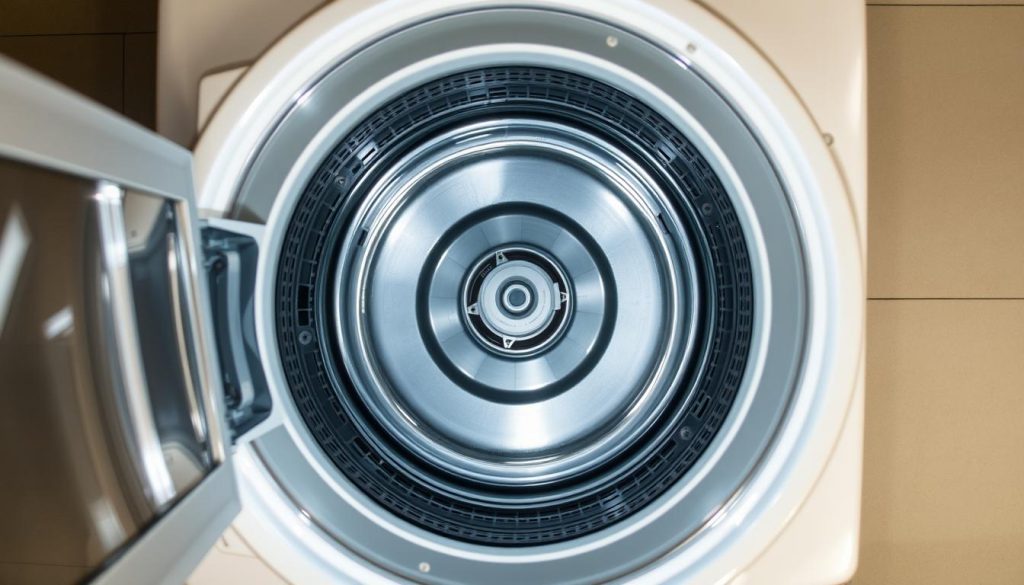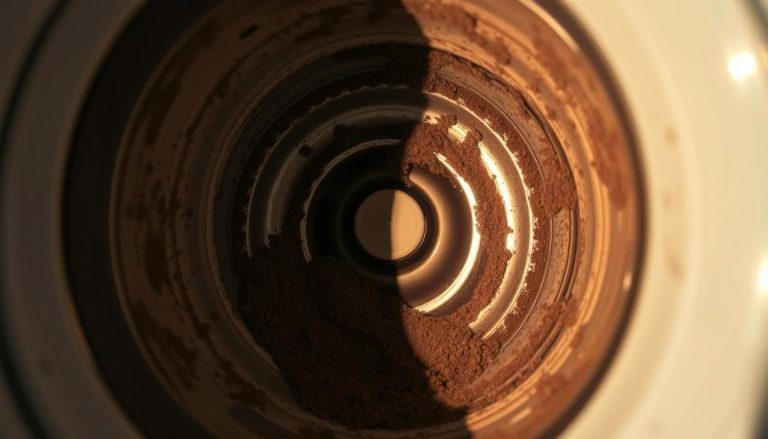Ever noticed a bad smell on your clothes after washing? Or maybe your top loader washing machine isn’t working as well as it used to? This could be because of sludge buildup inside. Sludge can make your clothes dirty and harm your machine’s life.
Cleaning your machine often can make it work better and last longer. In this guide, we’ll show you how to remove sludge and keep your top loader washing machine in great shape.
Key Takeaways
- Regular cleaning improves washing machine performance.
- Sludge buildup can cause unpleasant odors and poor cleaning results.
- Effective methods to remove sludge will be discussed.
- Maintenance tips to prevent future sludge accumulation.
- Steps to ensure the longevity of your top loader washing machine.
Table of Contents
Understanding Washing Machine Sludge
Sludge in your washing machine is made up of dirt, leftover detergent, and fabric softener. It can really slow down your washer and make it less clean. Knowing what sludge is and how it forms is key to fixing the issue.
What Is Washing Machine Sludge?
Sludge in your washer is a mix of dirt, leftover detergent, and fabric softener. It builds up over time and turns into a thick, sticky mess. This mess sticks to the inside of your washer.
Common Causes of Sludge Buildup
There are a few reasons why sludge builds up in your washer. Using too much detergent is one cause. Washing clothes in cold water can also cause problems. Not cleaning your washer often is another big reason.
Why Regular Cleaning Is Essential
Cleaning your washer regularly is important to stop sludge buildup. It keeps your washer working well and smelling good. Also, always leave the lid open after washing to dry the inside.
| Causes of Sludge Buildup | Effects on Washer | Prevention Methods |
|---|---|---|
| Excessive detergent use | Poor washing performance | Use recommended detergent amount |
| Cold water washing | Unpleasant odors | Regularly clean the washer |
| Infrequent washer cleaning | Sludge accumulation | Leave the lid open after use |
Signs Your Top Loader Needs Cleaning
A dirty top loader can cause poor washing results and bad smells. It’s important to know when it’s time to clean it. Regular care helps your appliance last longer and work better.
Visible Residue and Grime
Seeing residue or grime on clothes or in the washer drum means it’s dirty. This can come from leftover detergent, fabric softener, or debris. To fix this, you can:
- Check your detergent usage and adjust as necessary
- Run a cleaning cycle with a washing machine cleaner
- Wipe down the drum and lid after each use
Unpleasant Odors From Your Machine
Bad smells from your top loader mean it’s time for a clean. These smells can come from mold, mildew, or detergent buildup. To get rid of them, try leaving the lid open after use or run a hot water cycle with vinegar or a washing machine cleaner.
Poor Cleaning Performance
If your clothes aren’t clean, it might be because of sludge inside your top loader. Cleaning it regularly can improve its performance. Look for signs like dirty clothes or detergent residue on fabrics.
Unusual Noises During Operation
Strange noises during washing can mean sludge buildup or other problems. Regular cleaning can help reduce these noises and make your washer run smoother.
Tools and Materials Needed for Sludge Removal
To remove sludge buildup, you need the right cleaning agents and tools. Cleaning your top loader washing machine requires effective products and the right equipment.
Essential Cleaning Agents
Vinegar, baking soda, and bleach are great for cleaning. The Spruce says these are key for washing machine cleaning. Vinegar dissolves mineral deposits, baking soda is a gentle scrubber, and bleach fights tough grime and odors.
Necessary Tools
You’ll need a microfiber cloth for wiping, an old toothbrush for tight spots, and maybe a scrub brush for hard grime. These tools help reach and clean sludge buildup areas.
Protective Equipment
Remember to wear protective equipment like gloves and goggles. They keep you safe from harsh chemicals and debris while cleaning.
| Cleaning Agent | Purpose |
|---|---|
| Vinegar | Dissolves mineral deposits and tackles odor |
| Baking Soda | Acts as a gentle abrasive to remove grime |
| Bleach | Tackles tough grime and sanitizes |
Preparation Steps Before Cleaning
Getting ready is crucial for cleaning your top loader washing machine safely and well. Before you start cleaning, make sure to take a few steps first. This will help everything go smoothly.
Safety Precautions
First, make sure your washer is empty. Then, wear protective gloves and eyewear. This is to keep you safe from harsh cleaning agents.
Disconnecting Power and Water
Next, turn off the power to your washing machine. This stops it from starting up by accident. Also, turn off the water supply to avoid leaks or flooding. This step is key for your safety and to prevent damage.
| Step | Action | Purpose |
|---|---|---|
| 1 | Empty the washer | Ensure there’s no clothing or debris inside |
| 2 | Disconnect power | Prevent accidental start-ups |
| 3 | Turn off water supply | Avoid leaks or flooding |
Accessing Internal Components
Depending on your top loader model, you might need to get to parts like the dispenser and filters. Check your user manual to find these parts and learn how to remove them safely. This is key for a deep clean, like cleaning the top loader drum well.
How To Clean Sludge From Top Loader Using Vinegar Method
Removing sludge from your top loader washing machine is easy with vinegar. This method is both effective and eco-friendly. The Spruce suggests vinegar for washing machines because it’s natural and safe.
Setting Up the Cleaning Cycle
To begin, set up your washing machine for a cleaning cycle. Check your user manual for specific instructions. You’ll usually need to choose the hottest water and the largest load size.
Adding Vinegar to the Drum
After setting up, add the vinegar. You’ll need 1 to 2 cups of white vinegar. Pour it into the drum carefully, avoiding spills.
Running the Hot Water Cycle
Now, run the hot water cycle with the vinegar inside. The heat and vinegar’s acidity will break down the sludge and buildup.
Final Rinse Process
After the cycle, run a rinse cycle to remove vinegar residue. This step is key to ensure your machine is clean and free of vinegar smell. The Spruce recommends vinegar for keeping your machine clean and preventing sludge.
“Using vinegar to clean your washing machine is a simple, effective, and eco-friendly way to keep your appliance in top condition,” says cleaning experts. By following these steps, you can keep your top loader washing machine clean and working well.
The Baking Soda Method for Stubborn Sludge
Baking soda is a strong solution for tough sludge. It’s a natural and effective way to clean your washing machine.
Preparing the Baking Soda Solution
To begin, mix 1/4 cup of baking soda with 1/4 cup of hot water. This makes a paste that’s soft on your machine but tough on dirt.
Application Techniques
Spread the baking soda paste on the dirty spots. Make sure to cover them all. For really stubborn dirt, use more paste.

Soaking and Scrubbing Process
Let the paste soak for at least 30 minutes. Then, use a soft brush to scrub the area. For extra tough spots, soak longer before scrubbing.
Rinsing and Testing
Rinse well with warm water after scrubbing. Check if the dirt is gone. If not, you might need to do it again.
| Method | Effectiveness | Environmental Impact |
|---|---|---|
| Baking Soda Method | High | Low |
| Vinegar Method | Moderate | Low |
| Chemical Cleaners | High | High |
The baking soda method is not only effective but also good for the environment. It’s a better choice than harsh chemicals, making it ideal for top loader cleaning services that care about the planet.
Deep Cleaning the Agitator and Drum
Removing sludge from your washer means cleaning the agitator and drum well. This not only gets rid of grime and detergent but also makes your washer work better.
Removing the Agitator Safely
To clean the agitator, you must take it out first. Look in your washing machine’s manual to see if it can be removed and how. Usually, it’s a matter of lifting or unscrewing it. Be cautious because the agitator can be heavy and might be stuck.
Scrubbing Techniques for Stubborn Sludge
After taking out the agitator, use a soft-bristled brush or scrubber to gently clean the sludge. For hard grime, mix baking soda with water to make a paste. Apply it to the dirty spots, wait a few minutes, then scrub.
Cleaning Hard-to-Reach Areas
For corners and other hard spots, use a long-handled brush or a flexible tool. This helps get rid of sludge in these tricky spots.
Reassembling Components Correctly
After cleaning, put the agitator and other parts back together. Make sure they fit right to avoid problems during washing. If you’re not sure, check your user manual.
Tackling the Dispensers and Filters
To get your top loader really clean, don’t forget the dispensers and filters. They can easily get clogged with sludge. The Spruce says cleaning them often is key to keeping your washer running well.
Removing and Cleaning Dispensers
First, take out the dispensers as the manual tells you to. Soak them in warm soapy water to get rid of any leftover detergent. Then, use a soft brush to scrub off tough dirt. Rinse them well before putting them back.
Accessing and Cleaning Filters
Now, find and clean the filters in your top loader. They’re usually at the washer’s bottom or behind a panel. Use a soft-bristled brush and water to gently remove any dirt or buildup.
Dealing with Mineral Deposits
Mineral deposits can be tough to deal with. Mix equal parts water and white vinegar in the dispenser or run a cleaning cycle with a product made for mineral buildup. Regular maintenance is the best way to stop these deposits from forming.
Different Types of Top Loaders and Their Cleaning Requirements
Top loader washing machines come in various types, each with its own cleaning needs. Knowing your machine’s type is key to finding the right cleaning method.
Traditional Agitator Models
Traditional agitator models have a central post that moves clothes around. They tend to collect sludge around the agitator and below it. To clean these spots well, you might need to take out the agitator. Then, use a soft-bristled brush to remove any dirt.
High-Efficiency Top Loaders
High-efficiency (HE) top loaders use less water and are kinder to clothes. But, they can still get dirty because of their low-water setup. For these models, using HE detergent is crucial. Also, running a cleaning cycle with HE-specific products is important.
Brand-Specific Cleaning Considerations
Some brands have special cleaning tips. For example, certain models might need specific cleaning products or steps. Always check your user manual or the manufacturer’s website for top loader maintenance advice.

By knowing your top loader’s design and using the right cleaning method, you can keep it working well. This ensures your clothes stay clean and fresh.
Preventing Future Sludge Buildup
To stop sludge buildup, you need regular care and daily habits. Follow these tips to lower the chance of sludge in your top loader washing machine.
Regular Maintenance Schedule
Make a cleaning plan. Clean your washing machine every 1-2 months, based on how much you use it. Regular cleaning gets rid of detergent and fabric bits that cause sludge.
Best Practices for Daily Use
Use the right detergent and don’t overload the machine. Pick a detergent made for your machine and your water’s hardness.
Recommended Detergents and Additives
Go for detergents low in residue, made for high-efficiency machines if needed. Some cleaners or additives can cut down on sludge.
Leaving the Lid Open Between Uses
After each wash, keep the lid open. This lets the inside dry, which helps prevent sludge.
| Practice | Benefit |
|---|---|
| Regular Cleaning | Removes detergent residue and fabric scraps |
| Proper Detergent Use | Reduces residue buildup |
| Leaving the Lid Open | Reduces moisture buildup |
By doing these things, you can keep your top loader washing machine sludge-free. It will work better for longer.
Troubleshooting Persistent Sludge Problems
When DIY cleaning doesn’t work, it’s time to find the real cause. Sludge that keeps coming back might mean there’s a bigger mechanical problem. This could need a pro to fix.
When DIY Cleaning Doesn’t Work
If cleaning methods don’t clear sludge, it’s time to think again. Make sure you’re using the right cleaning products and the right cycle on your washer. The problem might be your detergent or the water temperature.
Identifying Deeper Mechanical Issues
Sludge that keeps coming back could mean a bigger problem. This could be a bad drain pump or clogged filters. Check these parts for wear or blockages that might be causing the sludge.
When to Call a Professional
If you can’t fix it yourself, it’s time to call a pro. They can find the problem and fix it. Don’t worry if you’re not sure what to do next or if the problem keeps coming back.
Understanding why sludge keeps coming back helps you clean your top loader drum right. This way, you can avoid future problems.
Conclusion
Keeping your top loader clean is crucial to avoid sludge buildup. Knowing why sludge forms and spotting early signs of buildup helps. This way, you can keep your washer running smoothly.
For a sludge-free washer, start with simple habits. Always leave the lid open after use and stick to recommended detergents. Cleaning the dispensers and filters regularly also helps. This ensures your washer keeps your clothes clean and fresh.
By following this guide, you can make your top loader cleaner and more efficient. Simple steps can prevent sludge and keep your washer reliable. Enjoy a cleaner, fresher laundry experience with these easy tips.
FAQ
What is washing machine sludge and how does it form?
How often should I clean my top loader washing machine to prevent sludge buildup?
Can I use bleach to clean sludge from my top loader washing machine?
How do I clean the dispensers and filters in my top loader?
What are the signs that my top loader needs cleaning?
Can I use the vinegar method for high-efficiency top loaders?
How do I prevent future sludge buildup in my top loader?
When should I call a professional to clean or repair my top loader?
Are there any specific cleaning considerations for traditional agitator models versus high-efficiency top loaders?
Can I use the baking soda method for cleaning my top loader’s agitator and drum?
Related Articles:

